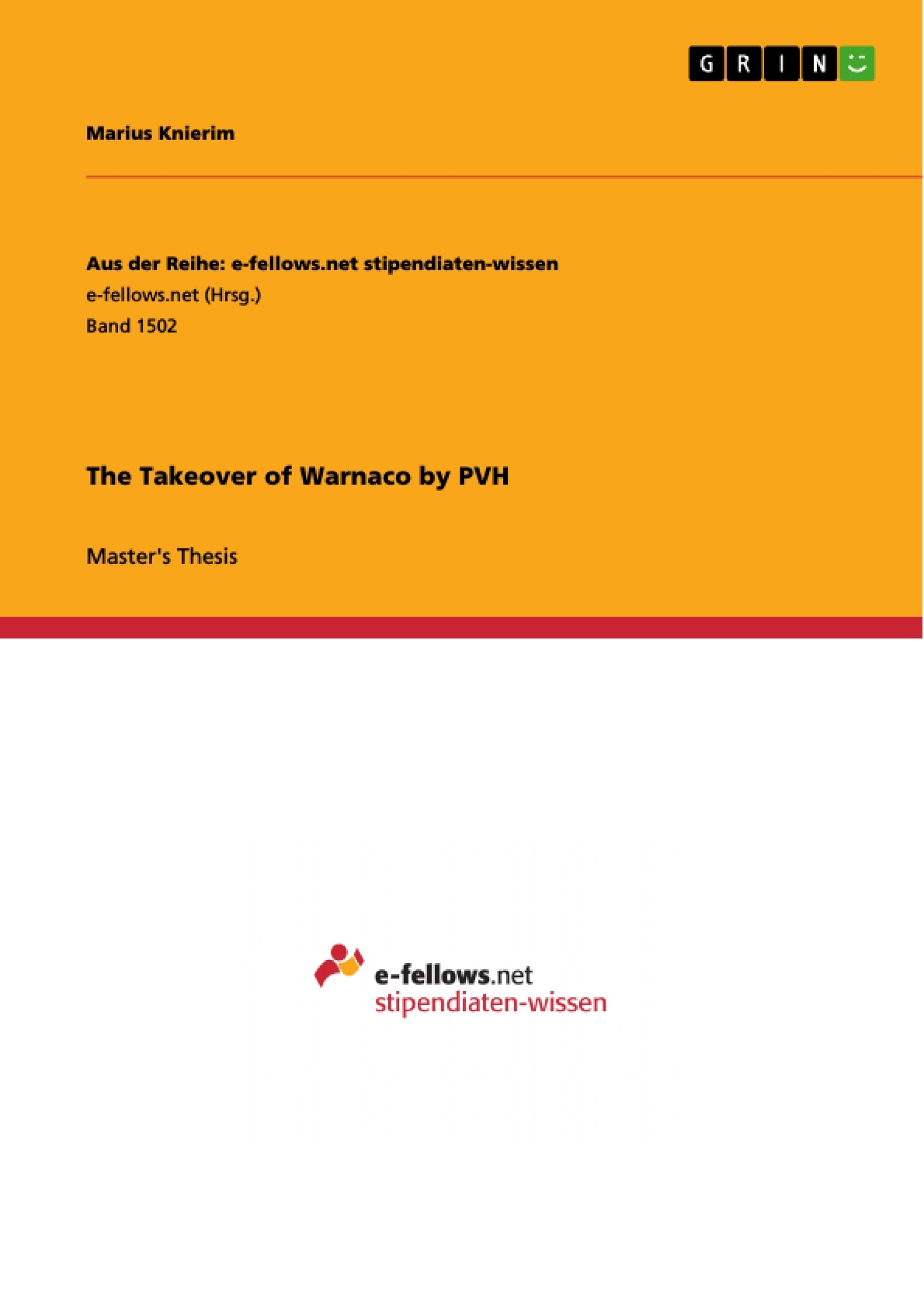The process of completing a merger of several companies or an acquisition of a company is a complex one, involving many different aspects. First, there is the target at hand, and the value of the very same. Second, it is to be determined which positive effect a combination of the businesses may have. Third, the interests of all involving stakeholders such as management, shareholders, investors or the workforce are to be recognized in the process. All of the above is dealt with by the parties involved and may lead to a merger agreement and a price to be paid. The question to be asked by academia is whether or not the price that has been agreed upon, was correct. Of course, this is a question of perspective and, at the same time, of the information available.
To answer this question, this thesis will make use of the transaction between PVH Corp. (PVH) and Warnaco Group (Warnaco), two American apparel companies, which on October
31st, 2012 announced that their businesses are to be combined by an acquisition of Warnaco through PVH. The deal was closed in February 2013.
The structure of the thesis is as follows. First, the market both companies operate in is analyzed, involving a market overview, a five forces analysis and a future outlook. Then a detailed description of the two companies follows, including their respective products, structures and histories. The picture will be rounded off by analyzing the deal rationale, deal characteristics and by giving a chronology of events related to the acquisition. The second part deals with the valuation of the companies using relative and fundamental valuation methods. Also incorporated in the fundamental valuation part, is a valuation of potential synergies. The third part then makes use of event study methodology to analyze whether the deal as a whole and price where reasonable according to stock market
assessment. A conclusion will then put together the results of all the conducted analysis and answer the question whether or not the transaction price was correct.
Inhaltsverzeichnis (Table of Contents)
- Introduction
- Chapter 1: The Global Economy and the Role of the State
- The Evolution of the Global Economy
- The Rise of Globalization
- The Role of the State in the Global Economy
- Chapter 2: Trade and Investment
- The Theory of Comparative Advantage
- The Gains from Trade
- Trade Barriers and Protectionism
- Foreign Direct Investment
- Chapter 3: The International Monetary System
- The Gold Standard
- The Bretton Woods System
- The Floating Exchange Rate System
- The Role of the International Monetary Fund
- Chapter 4: International Finance
- The Foreign Exchange Market
- International Debt and Currency Crises
- The Eurozone Crisis
- Chapter 5: Economic Integration and Regionalism
- The European Union
- The North American Free Trade Agreement
- The Asia-Pacific Economic Cooperation Forum
- Chapter 6: Development Economics
- Poverty and Inequality
- Theories of Economic Development
- Development Assistance
- Chapter 7: Global Environmental Issues
- Climate Change
- Sustainable Development
- International Environmental Agreements
- Conclusion
Zielsetzung und Themenschwerpunkte (Objectives and Key Themes)
This book aims to provide a comprehensive overview of the global economy, exploring its history, key institutions, and current challenges. The text examines the interconnectedness of national economies and the growing influence of globalization on economic activity.- The evolving role of the state in the global economy
- The benefits and challenges of international trade and investment
- The dynamics of the international monetary system
- The complexities of international finance and debt
- The impact of economic integration and regionalism
Zusammenfassung der Kapitel (Chapter Summaries)
- Chapter 1 examines the historical evolution of the global economy, highlighting the rise of globalization and the changing role of the state. It explores the factors that have contributed to the interconnectedness of national economies and the implications for economic policy.
- Chapter 2 delves into the theory of comparative advantage and the gains from international trade. It analyzes the impact of trade barriers and protectionism, as well as the role of foreign direct investment in promoting economic growth.
- Chapter 3 provides a detailed overview of the international monetary system, discussing its different phases, including the gold standard, the Bretton Woods system, and the current floating exchange rate system. It also examines the role of the International Monetary Fund in maintaining global financial stability.
- Chapter 4 focuses on the complexities of international finance, including the foreign exchange market, international debt, and currency crises. It analyzes the Eurozone crisis as a case study of the challenges facing global financial institutions.
- Chapter 5 explores the dynamics of economic integration and regionalism, examining the experiences of the European Union, the North American Free Trade Agreement, and the Asia-Pacific Economic Cooperation Forum.
- Chapter 6 examines the key issues in development economics, including poverty, inequality, and theories of economic development. It analyzes the role of development assistance in promoting sustainable growth in developing countries.
- Chapter 7 explores the growing importance of global environmental issues, focusing on climate change, sustainable development, and international environmental agreements.
Schlüsselwörter (Keywords)
The book explores key concepts and topics such as globalization, international trade, foreign direct investment, the international monetary system, international finance, economic integration, regionalism, development economics, and global environmental issues. It analyzes these concepts in the context of the global economy and their implications for policymakers and individuals.- Citar trabajo
- Marius Knierim (Autor), 2013, The Takeover of Warnaco by PVH, Múnich, GRIN Verlag, https://www.grin.com/document/299868



